A Novel Adaptively Optimized PCNN Model for Hyperspectral Image Sharpening
Abstract
:1. Introduction
2. Related Work
2.1. Standard PCNN Principle
2.2. Chameleon Swarm Optimization Algorithm
3. Proposed Method
3.1. SAM-CC Band Assignment Block
3.2. Improved PCNN Model
3.3. Automatic Parameter Optimization of IPCNN by CSA
3.4. Extracting MS Details
3.5. Adaptive Injected Gains
- (1)
- Initialize IPCNN. Let VF = 0.5, VL = 0.2, VE = 20, Y [0] = L [0] = U [0] = 0, E [0] = VE.
- (2)
- Optimize IPCNN parameters αF, αL, αE, β, and W using the CSA-based IPCNN optimization algorithm.
- (3)
- Obtain the irregular segmentation region of the IPCNN model in the current iteration n. And calculate the injected gain Gk[n] according to Equation (20).
3.6. Fusion Output
| Algorithm 1 AT-AIPCNN (“atrous” transform-adaptive IPCNN) method |
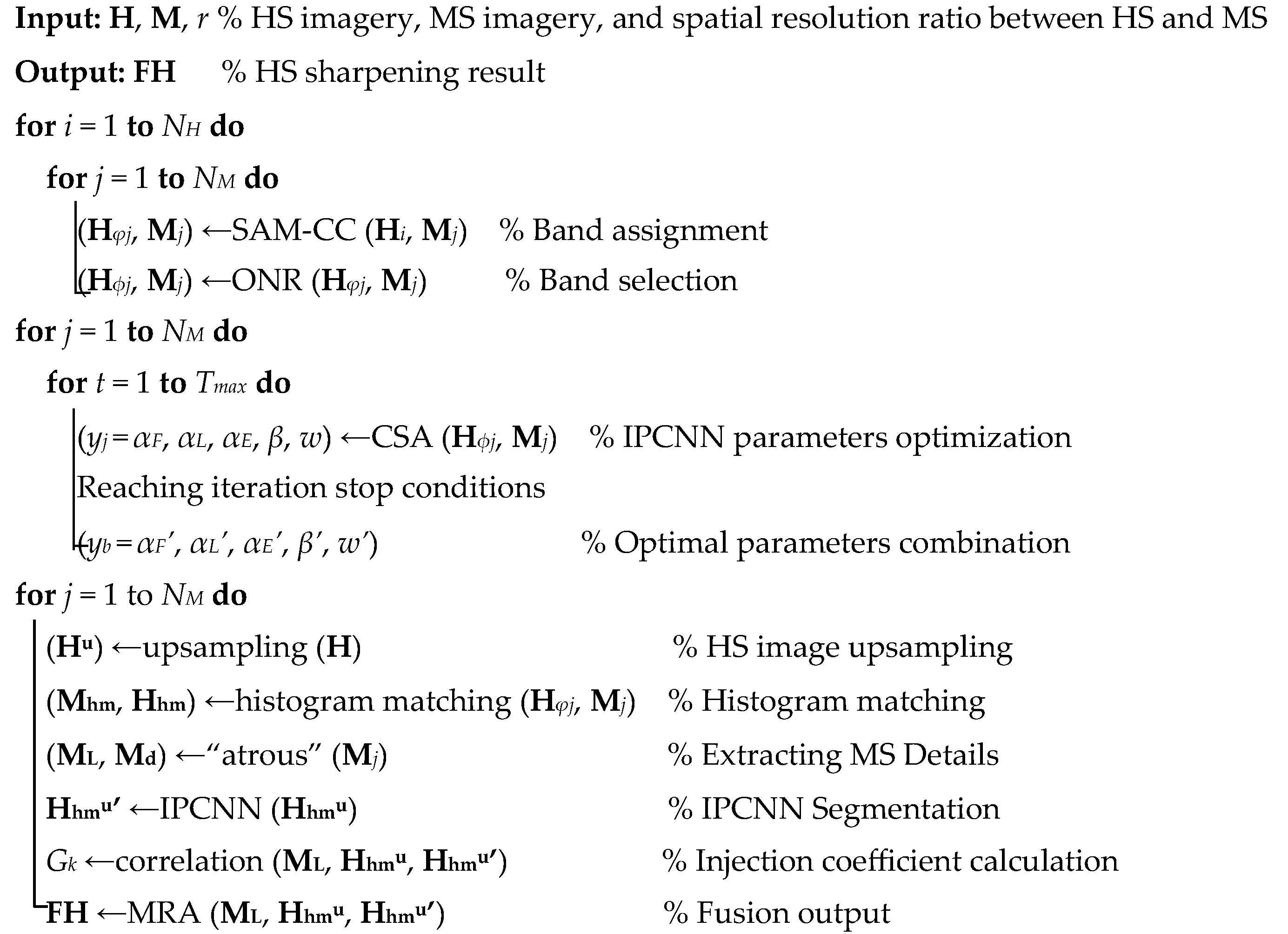 |
4. Experimental Results
4.1. Datasets
4.2. Experimental Setup
4.3. Experimental Results
4.4. Ablation Experiments
5. Conclusions
Author Contributions
Funding
Data Availability Statement
Acknowledgments
Conflicts of Interest
References
- Kokila, S.; Jayachandran, A. Hybrid Behrens-Fisher- and Gray Contrast–Based Feature Point Selection for Building Detection from Satellite Images. J. Geovisualization Spat. Anal. 2023, 7, 8. [Google Scholar] [CrossRef]
- Zheng, Z.; Hu, Y.; Yang, H.; Qiao, Y.; He, Y.; Zhang, Y.; Huang, Y. AFFU-Net: Attention feature fusion U-Net with hybrid loss for winter jujube crack detection. Comput. Electron. Agric. 2022, 198, 107049. [Google Scholar] [CrossRef]
- Gadea, O.; Khan, S. Detection of Bastnäsite-Rich Veins in Rare Earth Element Ores through Hyperspectral Imaging. IEEE Geosci. Remote Sens. Lett. 2023, 20, 1–4. [Google Scholar] [CrossRef]
- Boubanga-Tombet, S.; Huot, A.; Vitins, I.; Heuberger, S.; Veuve, C.; Eisele, A.; Hewson, R.; Guyot, E.; Marcotte, F.; Chamberland, M. Thermal Infrared Hyperspectral Imaging for Mineralogy Mapping of a Mine Face. Remote Sens. 2018, 10, 1518. [Google Scholar] [CrossRef]
- Vivone, G.; Dalla Mura, M.; Garzelli, A.; Restaino, R.; Scarpa, G.; Ulfarsson, M.O.; Alparone, L.; Chanussot, J. A New Benchmark Based on Recent Advances in Multispectral Pansharpening: Revisiting Pansharpening with Classical and Emerging Pansharpening Methods. IEEE Geosci. Remote Sens. Mag. 2020, 9, 53–81. [Google Scholar] [CrossRef]
- Jiayuan, L.; Ai, M.; Wang, S.; Hu, Q. GRF: Guided Residual Fusion for Pansharpening. Int. J. Remote Sens. 2022, 43, 3609–3627. [Google Scholar]
- Wu, Z.; Huang, Y.; Zhang, K. Remote Sensing Image Fusion Method Based on PCA and Curvelet Transform. J. Indian Soc. Remote Sens. 2018, 46, 687–695. [Google Scholar] [CrossRef]
- Kong, Y.; Hong, F.; Leung, H.; Peng, X. A Fusion Method of Optical Image and SAR Image Based on Dense-UGAN and Gram–Schmidt Transformation. Remote Sens. 2021, 13, 4274. [Google Scholar] [CrossRef]
- Garzelli, A.; Nencini, F.; Capobianco, L. Optimal MMSE pan sharpening of very high resolution multispectral images. IEEE Trans. Geosci. Remote Sens. 2008, 46, 228–236. [Google Scholar] [CrossRef]
- Vivone, G. Robust Band-Dependent Spatial-Detail Approaches for Panchromatic Sharpening. IEEE Trans. Geosci. Remote Sens. Publ. IEEE Geosci. Remote Sens. Soc. 2019, 57, 6421–6433. [Google Scholar] [CrossRef]
- Yang, Y.; Wan, C.; Huang, S.; Lu, H.; Wan, W. Pansharpening Based on Adaptive High-Frequency Fusion and Injection Coefficients Optimization. IEEE J. Sel. Top. Appl. Earth Obs. Remote Sens. 2023, 16, 799–811. [Google Scholar] [CrossRef]
- Dian, R.; Li, S.; Sun, B.; Guo, A. Recent advances and new guidelines on hyperspectral and multispectral image fusion. Inf. Fusion 2021, 69, 40–51. [Google Scholar] [CrossRef]
- Bouslihim, Y.; Kharrou, M.H.; Miftah, A.; Attou, T.; Bouchaou, L.; Chehbouni, A. Comparing Pan-sharpened Landsat-9 and Sentinel-2 for Land-Use Classification Using Machine Learning Classifiers. J. Geovisualization Spat. Anal. 2022, 6, 35. [Google Scholar] [CrossRef]
- Burt, P.; Adelson, E. The Laplacian Pyramid as a Compact Image Code. Read. Comput. Vis. 1987, 31, 671–679. [Google Scholar]
- Gao, W.; Xiao, Z.; Bao, T. Detection and Identification of Potato-Typical Diseases Based on Multidimensional Fusion Atrous-CNN and Hyperspectral Data. Appl. Sci. 2023, 13, 5023. [Google Scholar] [CrossRef]
- Jindal, H.; Bharti, M.; Kasana, S.; Saxena, S. An ensemble mosaicing and ridgelet based fusion technique for underwater panoramic image reconstruction and its refinement. Multimed. Tools Appl. Available online: https://link.springer.com/article/10.1007/s11042-023-14594-9 (accessed on 8 March 2023). [CrossRef]
- Du, C.; Gao, S. Remote sensing image fusion based on nonlinear IHS and fast nonsubsampled contourlet transform. J. Indian Soc. Remote Sens. 2018, 46, 2023–2032. [Google Scholar] [CrossRef]
- Cheng, S.; Qiguang, M.; Pengfei, X. A novel algorithm of remote sensing image fusion based on Shearlets and PCNN. Neurocomputing 2013, 117, 47–53. [Google Scholar] [CrossRef]
- Restaino, R.; Vivone, G.; Dalla Mura, M.; Chanussot, J. Fusion of multispectral and panchromatic images based on morphological operators. IEEE Trans. Image Process. 2016, 25, 2882–2895. [Google Scholar] [CrossRef] [PubMed]
- Ren, C.; Liang, Y.; Lu, X.; Yan, H. Research on the soil moisture sliding estimation method using the LS-SVM based on multi-satellite fusion. Int. J. Remote Sens. 2019, 40, 2104–2119. [Google Scholar] [CrossRef]
- Vivone, G. Multispectral and hyperspectral image fusion in remote sensing: A survey. Inf. Fusion 2023, 89, 405–417. [Google Scholar] [CrossRef]
- Gomez, R.; Jazaeri, A.; Kafatos, M. Wavelet-based hyperspectral and multispectral image fusion. Proc. SPIE-Int. Soc. Opt. Eng. 2001, 4383, 36–42. [Google Scholar]
- Chen, Z.; Pu, H.; Wang, B.; Jiang, G.-M. Fusion of Hyperspectral and Multispectral Images: A Novel Framework Based on Generalization of Pan-Sharpening Methods. IEEE Geosci. Remote Sens. Lett. 2014, 11, 1418–1422. [Google Scholar] [CrossRef]
- Picone, D.; Restaino, R.; Vivone, G.; Addesso, P.; Dalla Mura, M.; Chanussot, J. Band assignment approaches for hyperspectral sharpening. IEEE Geosci. Remote Sens. Lett. 2017, 14, 739–743. [Google Scholar] [CrossRef]
- Lu, X.; Zhang, J.; Yu, X.; Tang, W.; Li, T.; Zhang, Y. Hyper-sharpening based on spectral modulation. IEEE J. Sel. Top. Appl. Earth Obs. Remote Sens. 2019, 12, 1534–1548. [Google Scholar] [CrossRef]
- Yokoya, N.; Yairi, T.; Iwasaki, A. Coupled Nonnegative Matrix Factorization Unmixing for Hyperspectral and Multispectral Data Fusion. IEEE Trans. Geosci. Remote Sens. 2012, 50, 528–537. [Google Scholar] [CrossRef]
- Dian, R.; Li, S.; Fang, L.; Lu, T.; Bioucas-Dias, J.M. Nonlocal Sparse Tensor Factorization for Semiblind Hyperspectral and Multispectral Images Fusion. IEEE Trans. Cybern. 2020, 50, 4469–4480. [Google Scholar] [CrossRef]
- Li, J.; Hong, D.; Gao, L.; Yao, J.; Zheng, K.; Zhang, B.; Chanussot, J. Deep learning in multimodal remote sensing data fusion: A comprehensive review. Int. J. Appl. Earth Obs. Geoinf. 2022, 112, 102926. [Google Scholar] [CrossRef]
- Liu, J.; Yuan, Z.; Pan, Z.; Fu, Y.; Liu, L.; Lu, B. Diffusion Model with Detail Complement for Super-Resolution of Remote Sensing. Remote Sens. 2022, 14, 4834. [Google Scholar] [CrossRef]
- Zhang, L.; Nie, J.; Wei, W.; Li, Y.; Zhang, Y. Deep blind hyperspectral image super-resolution. IEEE Trans. Neural Netw. Learn. Syst. 2021, 32, 2388–2400. [Google Scholar] [CrossRef]
- Qu, Y.; Qi, H.; Kwan, C.; Yokoya, N.; Chanussot, J. Unsupervised and unregistered hyperspectral image super-resolution with mutual Dirichlet-Net. IEEE Trans. Geosci. Remote Sens. 2022, 60, 1–18. [Google Scholar] [CrossRef]
- Li, X.; Yan, H.; Xie, W.; Kang, L.; Tian, Y. An Improved Pulse-Coupled Neural Network Model for Pansharpening. Sensors 2020, 20, 2764. [Google Scholar] [CrossRef] [PubMed]
- Zhang, L.; Zeng, G.; Wei, J.; Xuan, Z. Multi-modality image fusion in adaptive-parameters SPCNN based on inherent characteristics of image. IEEE Sens. J. 2020, 20, 11820–11827. [Google Scholar] [CrossRef]
- Bhagyashree, V.; Manisha, D.; Mohammad, F.; Avinash, G.; Deep, G. Saliency Detection Using a Bio-inspired Spiking Neural Network Driven by Local and Global Saliency. Appl. Artif. Intell. 2022, 36, 2900–2928. [Google Scholar]
- Huang, C.; Tian, G.; Lan, Y.; Peng, Y.; Ng, E.; Hao, Y.; Che, W. A new pulse coupled neural network (PCNN) for brain medical image fusion empowered by shuffled frog leaping algorithm. Front. Neurosci. 2019, 13, 210. [Google Scholar] [CrossRef]
- Panigrahy, C.; Seal, A.; Mahato, N. Fractal dimension based parameter adaptive dual channel PCNN for multi-focus image fusion. Opt. Lasers Eng. 2020, 133, 106141. [Google Scholar] [CrossRef]
- Panigrahy, C.; Seal, A.; Gonzalo-Martín, C.; Pathak, P.; Jalal, A. Parameter adaptive unit-linking pulse coupled neural network based MRI-PET/SPECT image fusion. Biomed. Signal Process. Control 2023, 83, 104659. [Google Scholar] [CrossRef]
- Johnson, J.; Padgett, M. PCNN models and applications. IEEE Trans. Neural Netw. 1999, 10, 480–498. [Google Scholar] [CrossRef]
- Braik, M. Chameleon Swarm Algorithm: A Bio-inspired Optimizer for Solving Engineering Design Problems. Expert Syst. Appl. 2021, 174, 114685. [Google Scholar] [CrossRef]
- Ren, K.; Sun, W.; Meng, X.; Yang, G.; Du, Q. Fusing China GF-5 Hyperspectral Data with GF-1, GF-2 and Sentinel-2A Multispectral Data: Which Methods Should Be Used? Remote Sens. 2020, 12, 882. [Google Scholar] [CrossRef]
- Wang, Q.; Zhang, F.; Li, X. Hyperspectral band selection via optimal neighborhood reconstruction. IEEE Trans. Geosci. Remote Sens. 2020, 58, 8465–8476. [Google Scholar] [CrossRef]
- Liu, J. Smoothing Filter-based Intensity Modulation: A spectral preserve image fusion technique for improving spatial details. Int. J. Remote Sens. 2000, 21, 3461–3472. [Google Scholar] [CrossRef]
- Aiazzi, B.; Alparone, L.; Baronti, S.; Garzelli, A.; Selva, M. MTF-tailored Multiscale Fusion of High-resolution MS and Pan Imagery. Photogramm. Eng. Remote Sens. 2015, 72, 591–596. [Google Scholar] [CrossRef]
- Simões, M.; Bioucas-Dias, J.; Almeida, L.B.; Chanussot, J. A Convex Formulation for Hyperspectral Image Superresolution via Subspace-Based Regularization. IEEE Trans. Geosci. Remote Sens. 2015, 53, 3373–3388. [Google Scholar] [CrossRef]
- Wei, Q.; Bioucas-Dias, J.; Dobigeon, N.; Tourneret, J.-Y. Hyperspectral and Multispectral Image Fusion Based on a Sparse Representation. IEEE Trans. Geosci. Remote Sens. 2015, 53, 3658–3668. [Google Scholar] [CrossRef]
- Li, J.; Zheng, K.; Yao, J.; Gao, L.; Hong, D. Deep Unsupervised Blind Hyperspectral and Multispectral Data Fusion. IEEE Geosci. Remote Sens. Lett. 2022, 19, 6007305. [Google Scholar] [CrossRef]
- Yokoya, N.; Grohnfeldt, C.; Chanussot, J. Hyperspectral and Multispectral Data Fusion: A comparative review of the recent literature. IEEE Geosci. Remote Sens. Mag. 2017, 5, 29–56. [Google Scholar] [CrossRef]
- Sara, D.; Mandava, A.K.; Kumar, A.; Duela, S.; Jude, A. Hyperspectral and multispectral image fusion techniques for high resolution applications: A review. Earth Sci. Inform. 2021, 14, 1685–1705. [Google Scholar] [CrossRef]
- Wang, Z.; Bovik, A.C.; Sheikh, H.R.; Simoncelli, E.P. Image Quality Assessment: From Error Visibility to Structural Similarity. IEEE Trans. Image Process. 2004, 13, 600–612. [Google Scholar] [CrossRef]
- Brunet, D.; Vrscay, E.R.; Wang, Z. On the mathematical properties of the structural similarity index. IEEE Trans. Image Process. 2011, 21, 1488–1499. [Google Scholar] [CrossRef]
- Tian, X.; Li, K.; Zhang, W.; Wang, Z.; Ma, J. Interpretable Model-Driven Deep Network for Hyperspectral, Multispectral, and Panchromatic Image Fusion. IEEE Trans. Neural Netw. Learn. Syst. Available online: https://ieeexplore.ieee.org/document/10138912 (accessed on 31 May 2023). [CrossRef]
- Li, S.; Dian, R.; Fang, L.; Bioucas-Dias, J. Fusing Hyperspectral and Multispectral Images via Coupled Sparse Tensor Factorization. IEEE Trans. Image Process. 2018, 27, 4118–4130. [Google Scholar] [CrossRef] [PubMed]
- Xue, J.; Shen, B. A novel swarm intelligence optimization approach: Sparrow search algorithm. Syst. Sci. Control Eng. 2020, 8, 22–34. [Google Scholar] [CrossRef]
- Nadimi-Shahraki, M.; Taghian, S.; Mirjalili, S. An improved grey wolf optimizer for solving engineering problems. Expert Syst. Appl. 2020, 166, 113917. [Google Scholar] [CrossRef]
- Nadimi-Shahraki, M.; Zamani, H.; Mirjalili, S. Enhanced whale optimization algorithm for medical feature selection: A COVID-19 case study. Comput. Biol. Med. 2022, 148, 105858. [Google Scholar] [CrossRef]

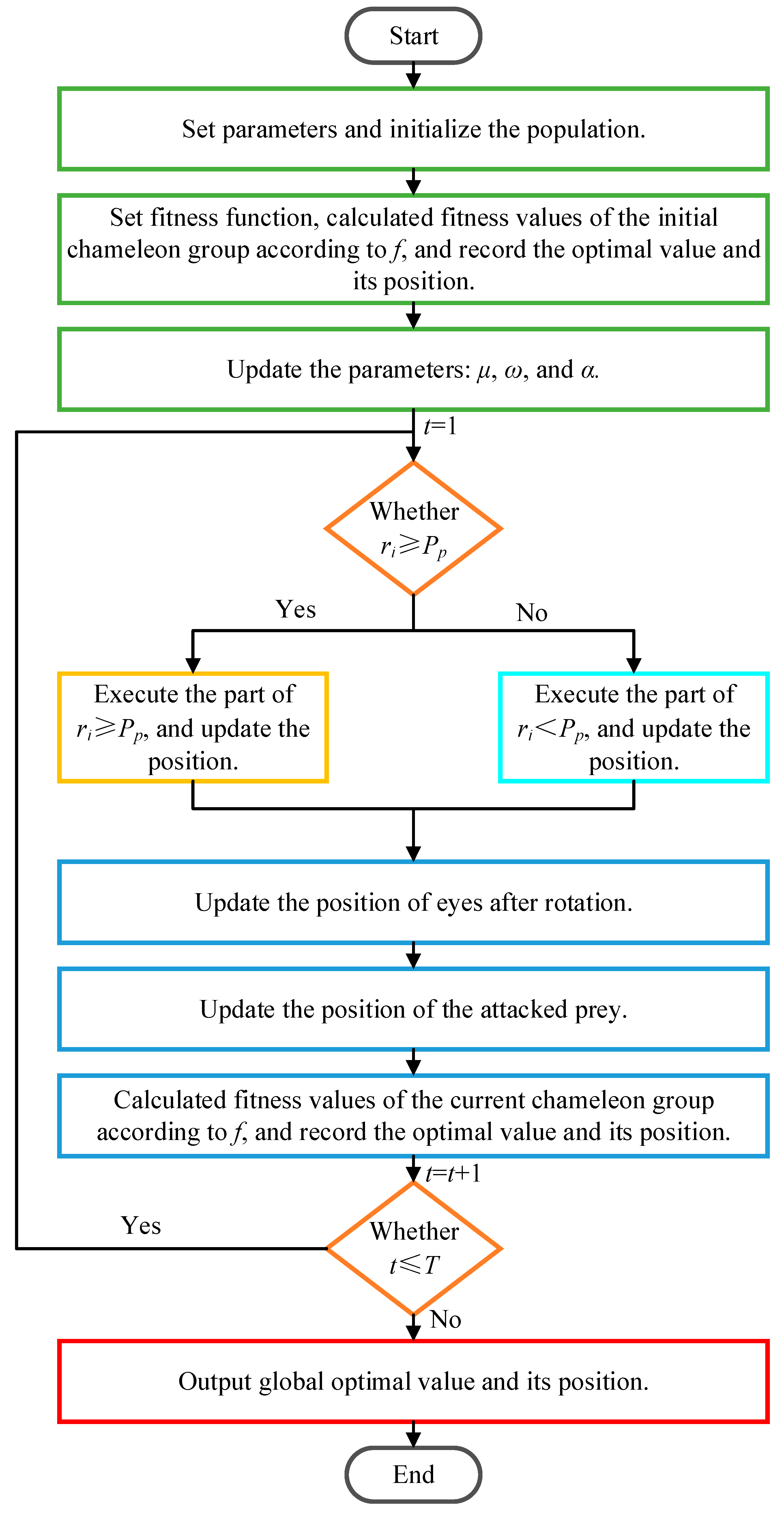
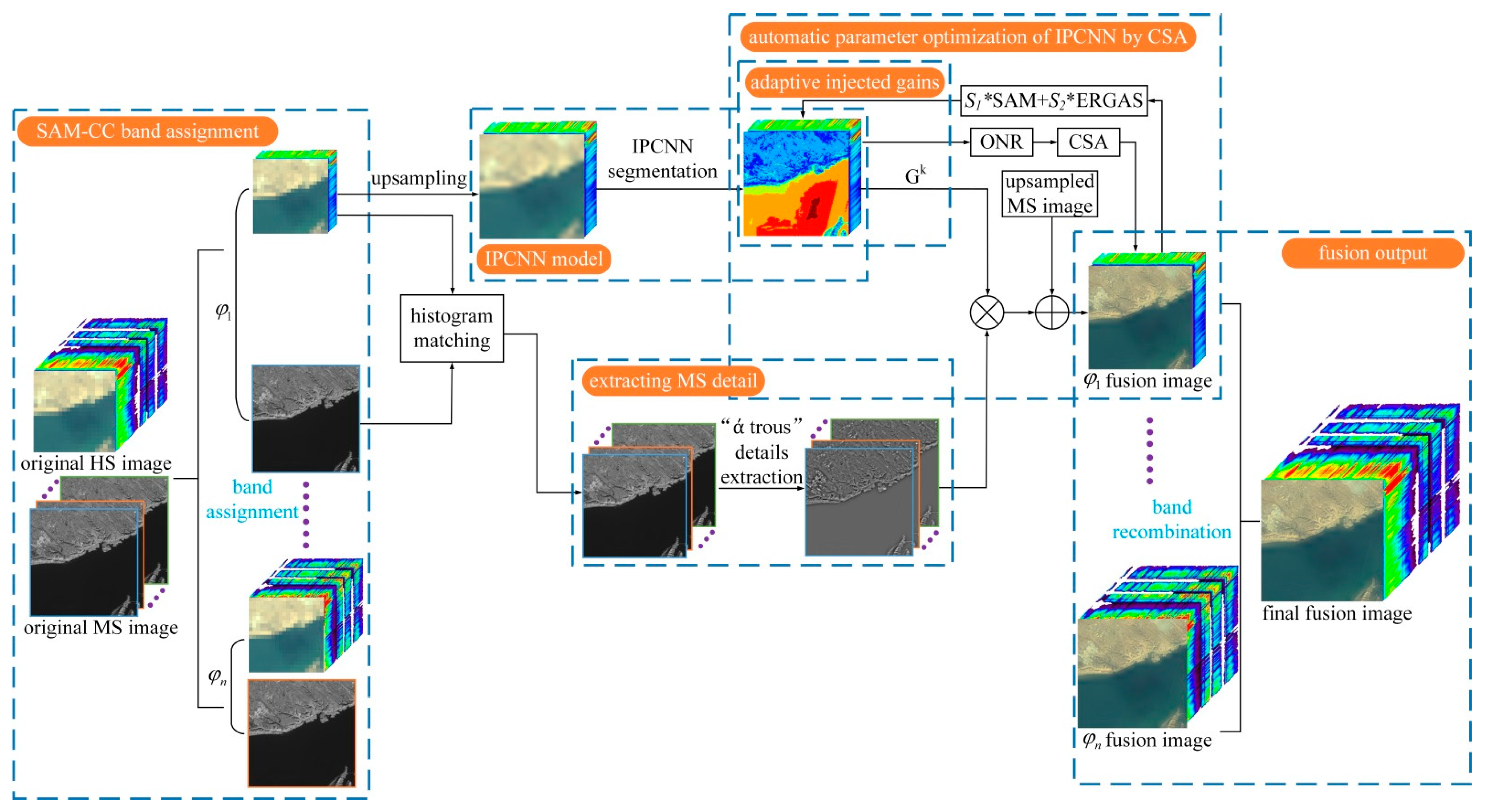
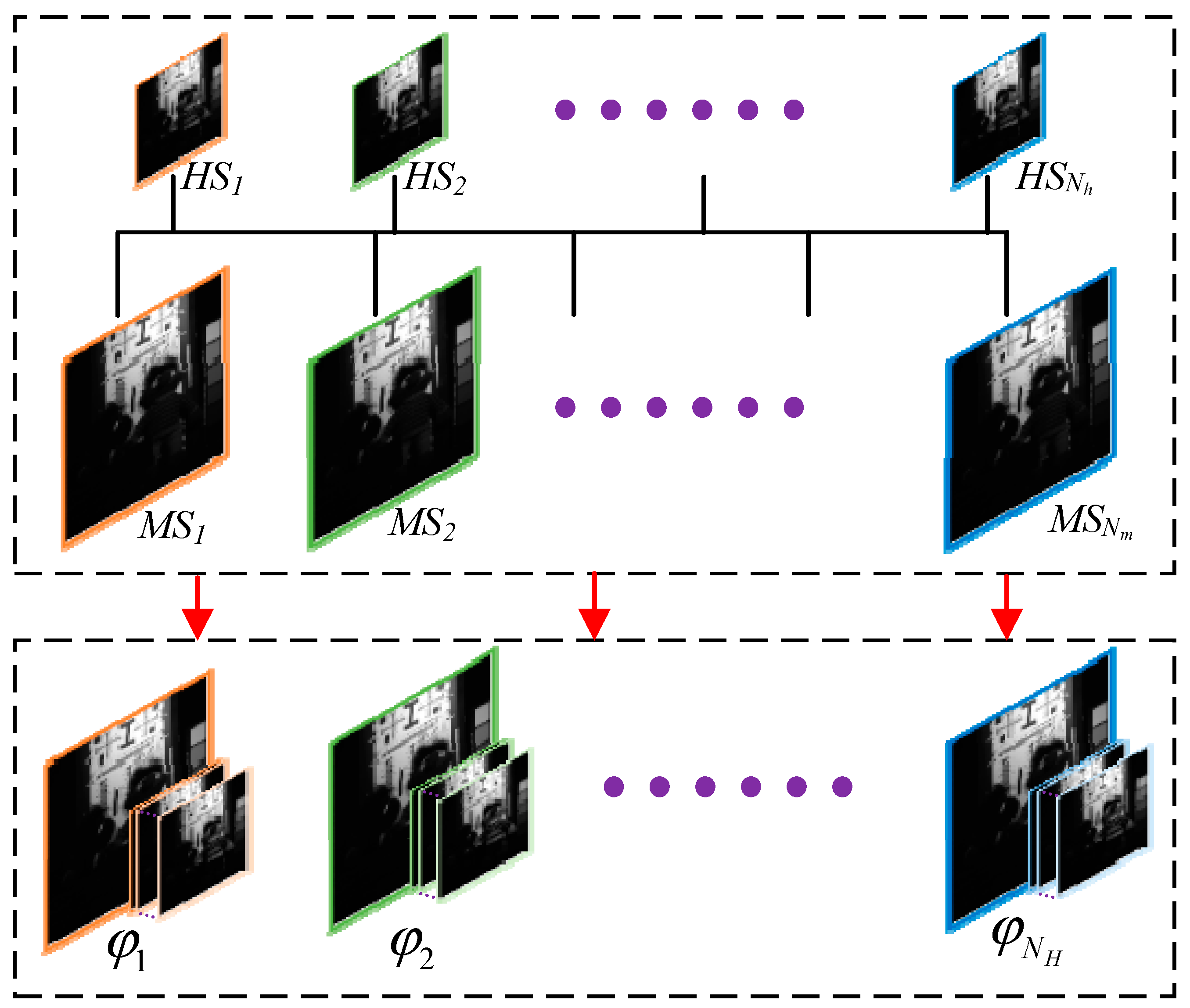
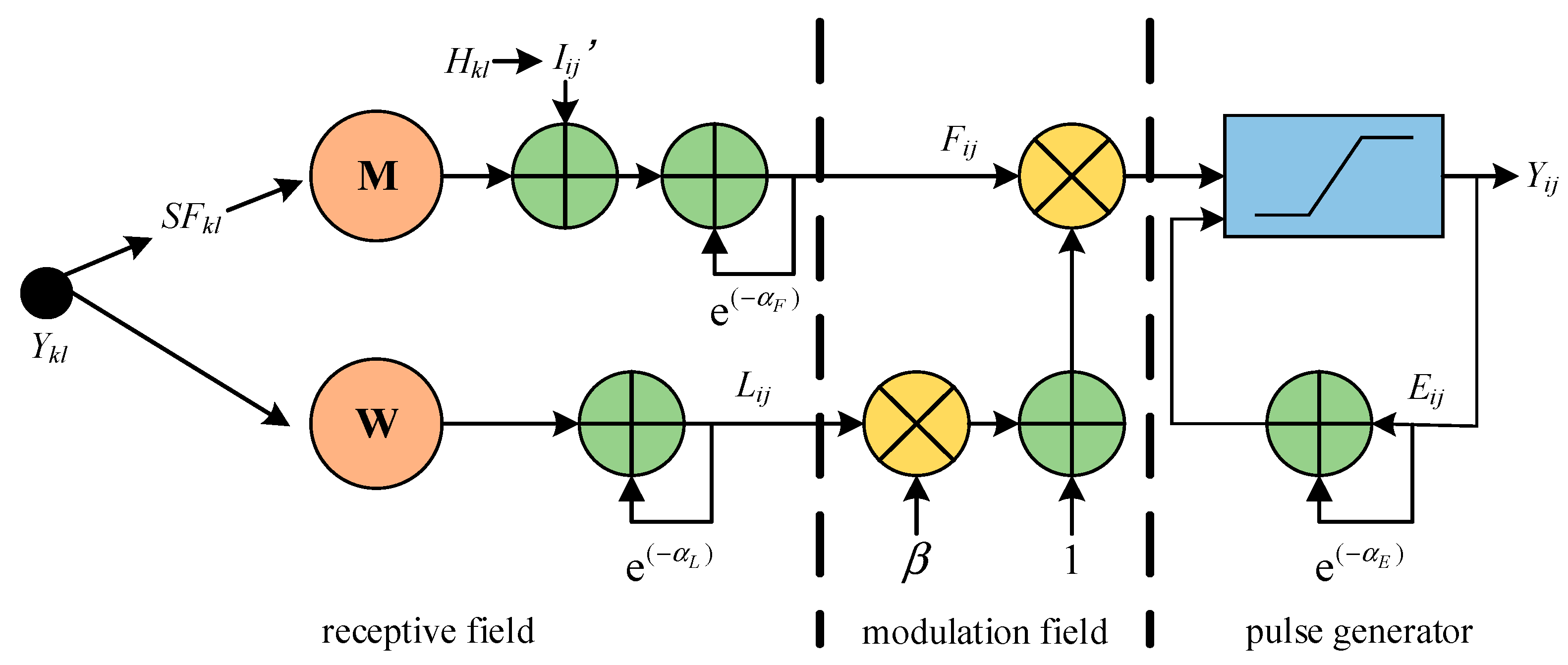


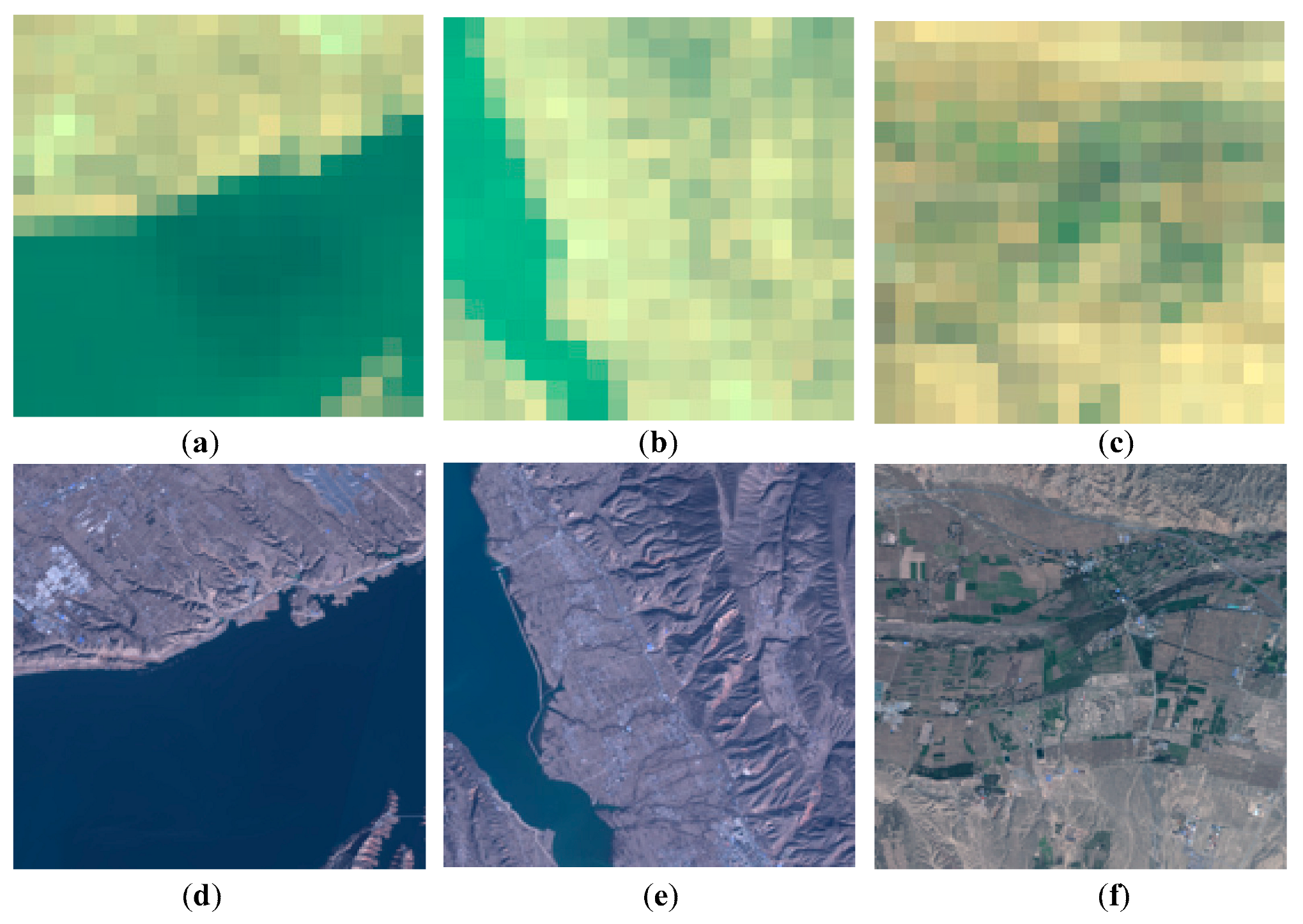

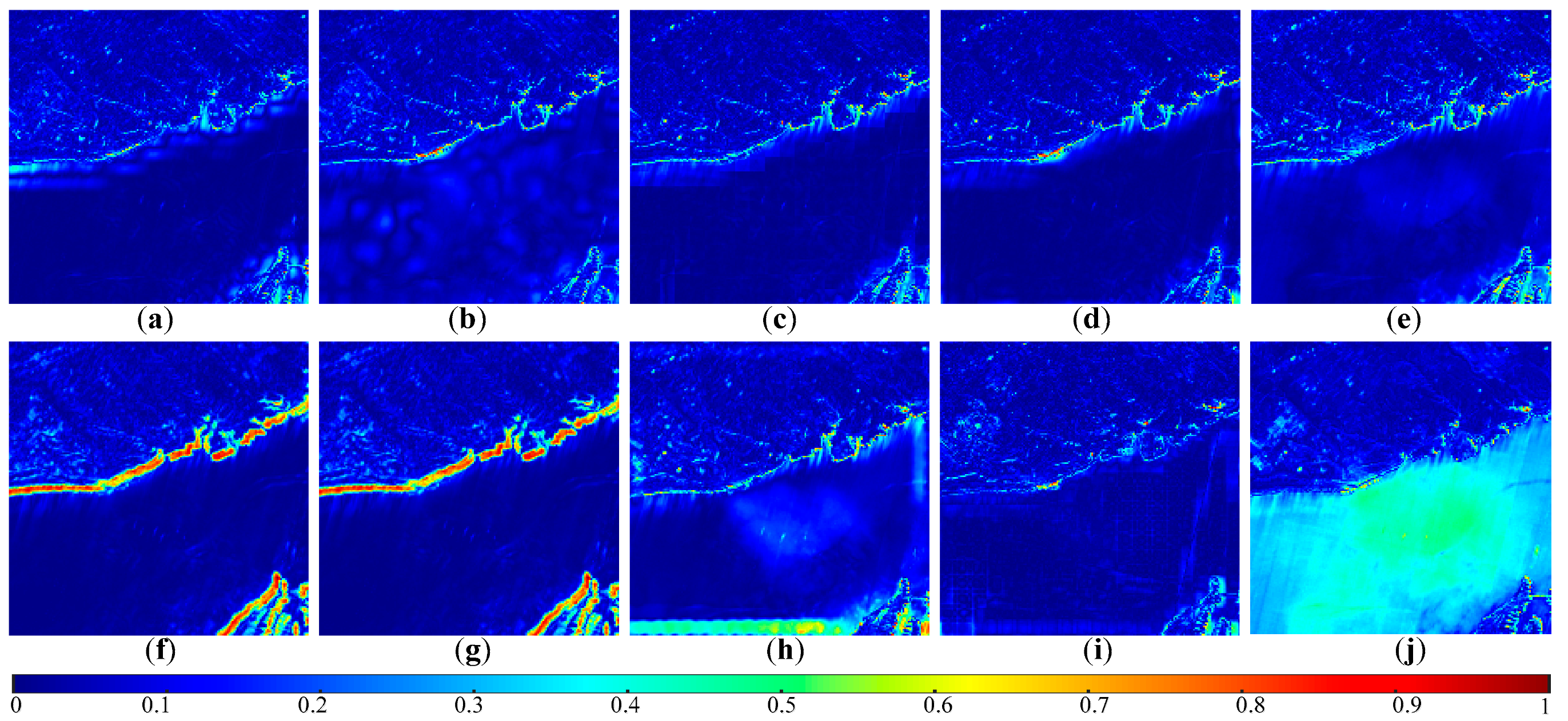
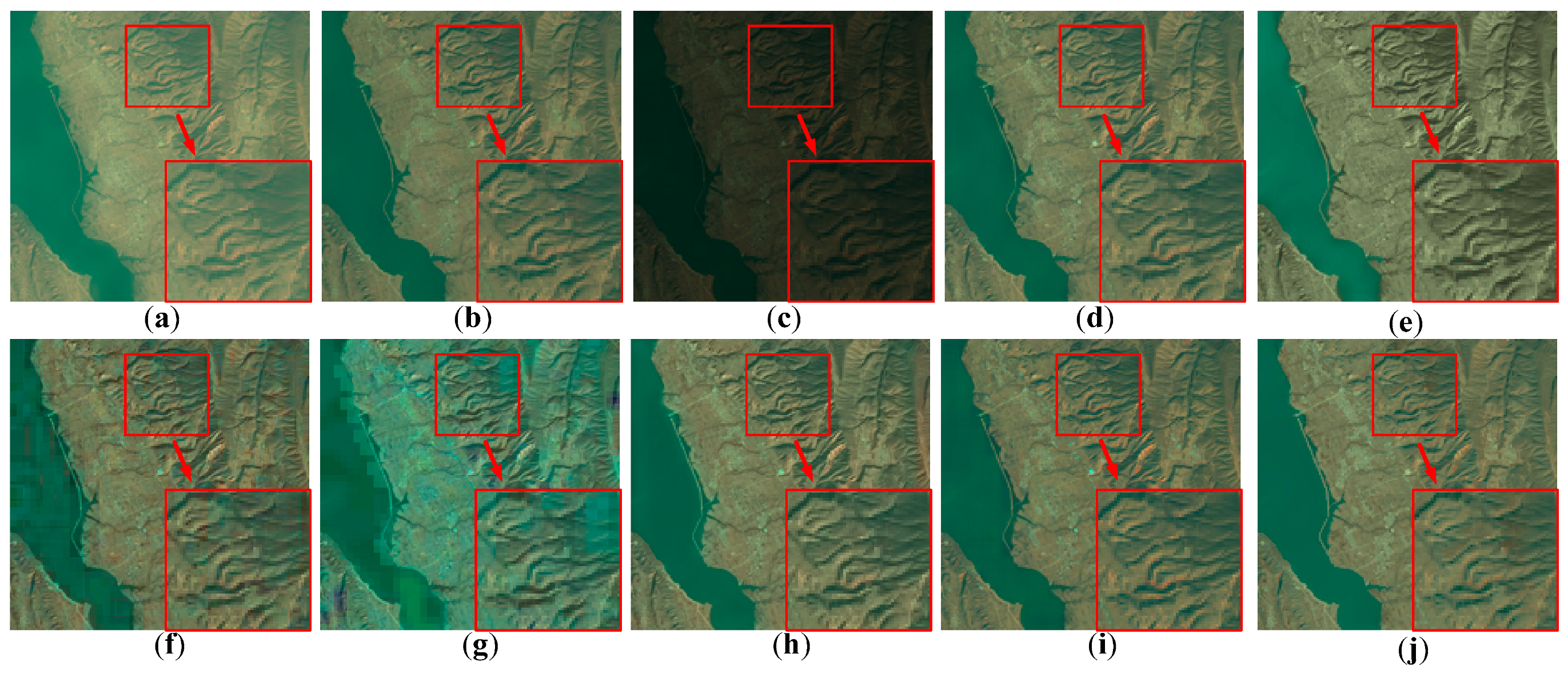

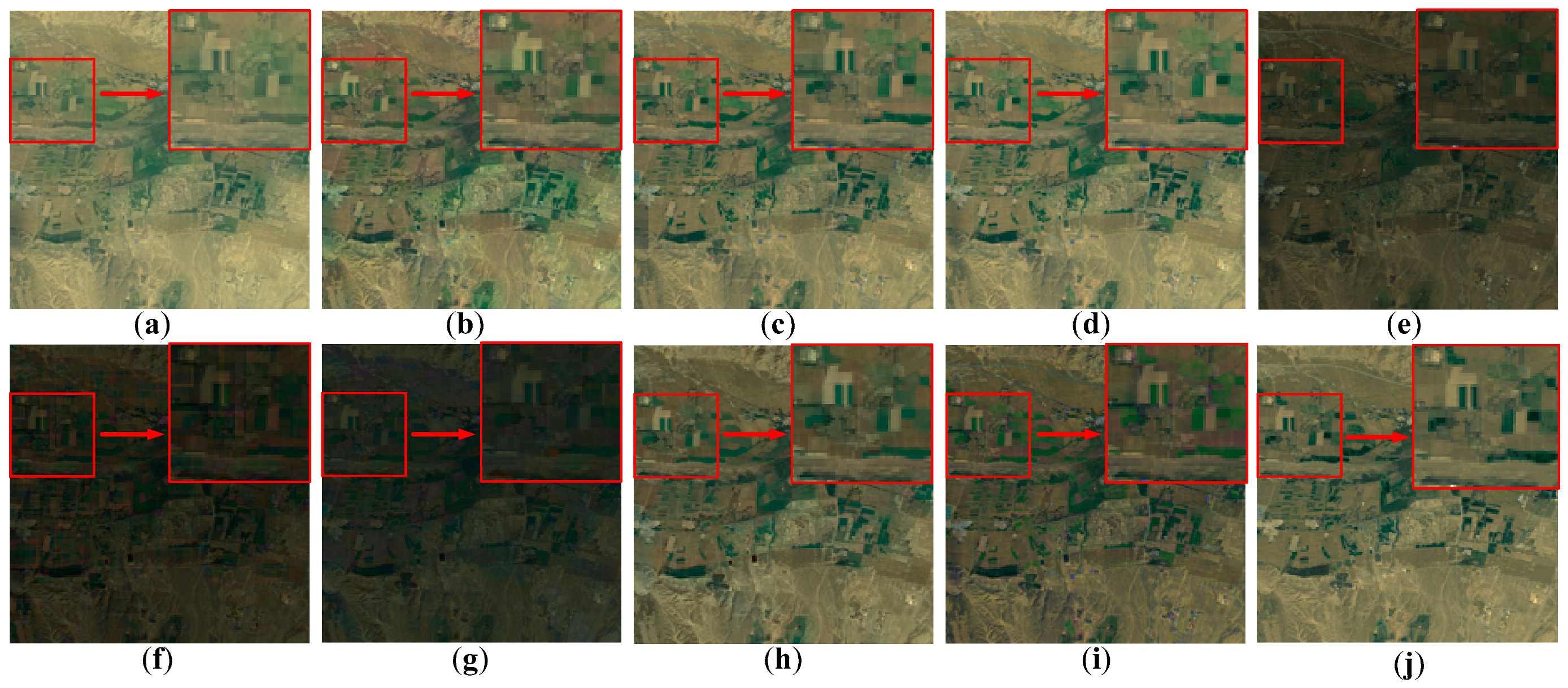
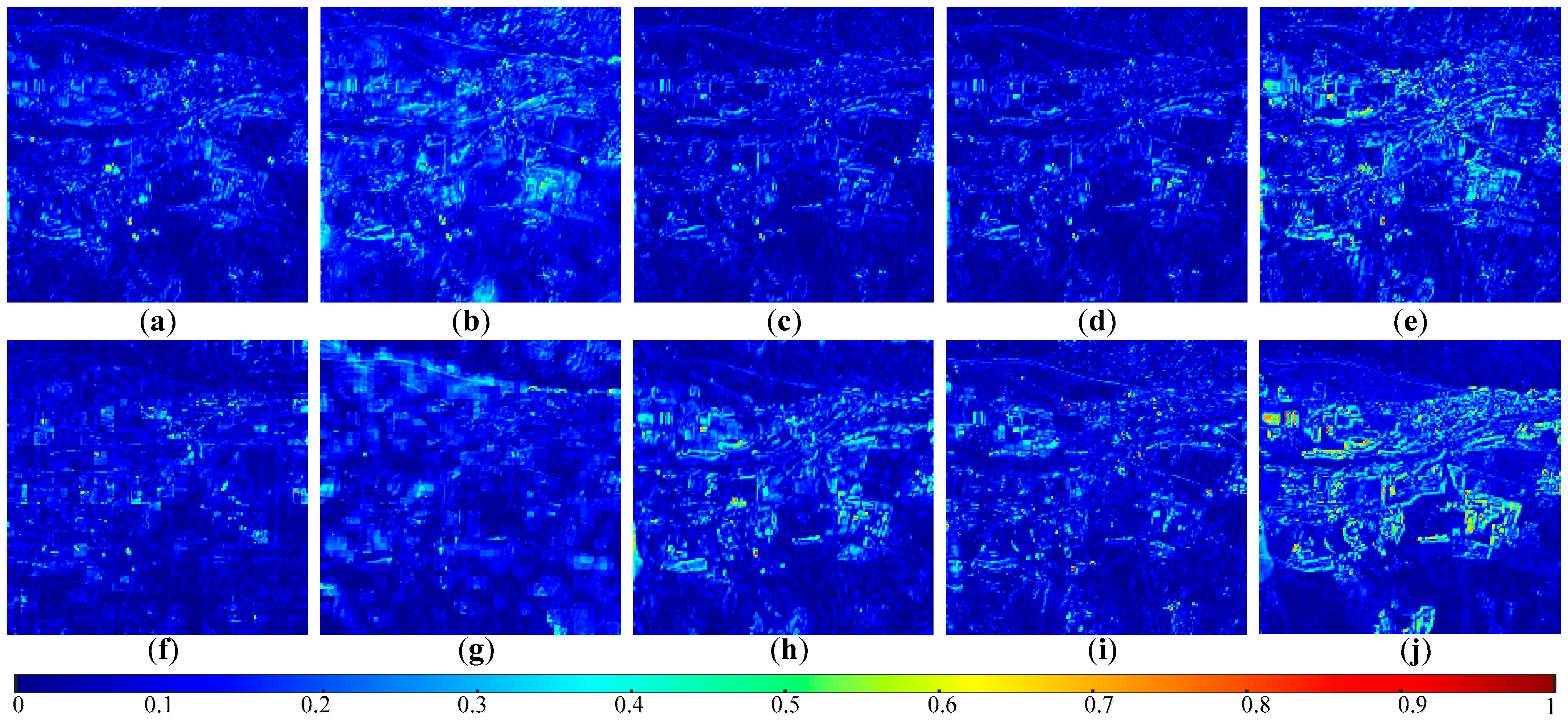
| Method | Main Parameters |
|---|---|
| NLSTF/NLSTF_SMBF | The atomic numbers for three different dictionaries: lW = 10, lH = 10, lS = 14. Parameters of sparse regularization: λ = 10−6, λ1 = 10−5, λ2 = 10−5, λ3 = 10−6. Cluster scaling parameter: K = 151. The spectral response matrix R was estimated by HYSURE [44]. |
| Method | PSNR (dB) | RMSE | ERGAS | SAM (°) | UIQI | SSIM | DD | CC |
|---|---|---|---|---|---|---|---|---|
| Proposed | 37.6677 | 5.0560 | 1.2971 | 1.5961 | 0.7252 | 0.9296 | 2.3748 | 0.9863 |
| GSA | 27.6248 | 17.2337 | 5.1195 | 2.1357 | 0.5535 | 0.8875 | 11.6032 | 0.9767 |
| SFIM | 25.8724 | 21.2343 | 6.8882 | 1.7852 | 0.5902 | 0.8613 | 14.6026 | 0.9768 |
| GLP | 25.6146 | 21.8812 | 7.2056 | 1.7573 | 0.5920 | 0.8588 | 15.0508 | 0.9777 |
| CNMF | 26.7564 | 18.9197 | 5.8796 | 2.1720 | 0.4619 | 0.8707 | 12.8621 | 0.9653 |
| NLSTF | 26.7253 | 18.3908 | 4.4832 | 5.3202 | 0.3553 | 0.7393 | 11.5977 | 0.8935 |
| NLSTF_SMBF | 25.4524 | 19.5991 | 7.4406 | 9.6997 | 0.2621 | 0.6833 | 12.1336 | 0.8094 |
| HYSURE | 27.9512 | 16.5909 | 4.8475 | 2.2759 | 0.4725 | 0.8862 | 11.2004 | 0.9685 |
| FUSE | 23.1458 | 29.1700 | 11.5544 | 3.7671 | 0.4466 | 0.7746 | 20.1469 | 0.9606 |
| UDALN | 30.1948 | 13.0902 | 3.1310 | 6.7527 | 0.4611 | 0.8917 | 8.4485 | 0.9555 |
| Method | PSNR (dB) | RMSE | ERGAS | SAM (°) | UIQI | SSIM | DD | CC |
|---|---|---|---|---|---|---|---|---|
| Proposed | 36.2331 | 5.7254 | 0.9960 | 1.9634 | 0.8498 | 0.9067 | 3.4608 | 0.9645 |
| GSA | 27.7164 | 16.0083 | 3.0327 | 2.6527 | 0.8158 | 0.8716 | 12.4741 | 0.9393 |
| SFIM | 17.7201 | 52.0659 | 22.7315 | 2.5678 | 0.3656 | 0.5387 | 42.0473 | 0.9452 |
| GLP | 29.1091 | 13.5721 | 2.4955 | 2.3762 | 0.8256 | 0.8826 | 10.5857 | 0.9526 |
| CNMF | 29.4453 | 12.4878 | 2.3389 | 2.8221 | 0.7854 | 0.8723 | 8.9418 | 0.8916 |
| NLSTF | 26.7873 | 16.4622 | 3.5301 | 4.5579 | 0.6711 | 0.7826 | 12.6480 | 0.8645 |
| NLSTF_SMBF | 22.4454 | 27.2926 | 9.9383 | 13.5531 | 0.4817 | 0.6763 | 20.5441 | 0.7075 |
| HYSURE | 29.1139 | 13.4809 | 2.4710 | 2.5469 | 0.8084 | 0.8665 | 10.3741 | 0.9299 |
| FUSE | 27.7103 | 16.0556 | 3.0428 | 2.8151 | 0.7959 | 0.8657 | 12.5806 | 0.9403 |
| UDALN | 28.3250 | 13.5625 | 2.5555 | 2.7875 | 0.7535 | 0.8709 | 10.3336 | 0.8834 |
| Method | PSNR (dB) | RMSE | ERGAS | SAM (°) | UIQI | SSIM | DD | CC |
|---|---|---|---|---|---|---|---|---|
| Proposed | 31.8816 | 11.0828 | 1.8716 | 4.4585 | 0.4979 | 0.6417 | 7.1603 | 0.7057 |
| GSA | 30.6948 | 12.9507 | 2.4569 | 5.1439 | 0.4744 | 0.6385 | 8.6661 | 0.6708 |
| SFIM | 30.4540 | 13.0830 | 2.5290 | 5.4665 | 0.4785 | 0.6243 | 8.5827 | 0.6538 |
| GLP | 31.4697 | 11.7546 | 2.2168 | 5.3264 | 0.4885 | 0.6284 | 7.2407 | 0.6606 |
| CNMF | 26.2153 | 21.5673 | 4.4503 | 6.3250 | 0.2844 | 0.5582 | 15.7905 | 0.4523 |
| NLSTF | 19.0226 | 51.3424 | 23.8635 | 12.8057 | 0.1418 | 0.3850 | 41.4662 | 0.3664 |
| NLSTF_SMBF | 19.5615 | 48.5621 | 21.1652 | 10.6630 | 0.1434 | 0.4451 | 38.9230 | 0.3652 |
| HYSURE | 26.1247 | 22.0403 | 4.6897 | 5.4368 | 0.4061 | 0.5953 | 16.4566 | 0.5652 |
| FUSE | 23.8007 | 29.0302 | 7.0905 | 7.2528 | 0.3347 | 0.5344 | 22.4866 | 0.5202 |
| UDALN | 27.9588 | 17.2212 | 2.9768 | 6.1002 | 0.3413 | 0.6091 | 12.1402 | 0.4833 |
| Method | PSNR (dB) | RMSE | ERGAS | SAM (°) | UIQI | SSIM | DD | CC |
|---|---|---|---|---|---|---|---|---|
| SAM-CC (dataset1) | 37.6677 | 5.0560 | 1.2971 | 1.5961 | 0.7252 | 0.9296 | 2.3748 | 0.9863 |
| SAM (dataset1) | 37.1726 | 5.2919 | 1.4142 | 1.7293 | 0.7139 | 0.9215 | 2.5195 | 0.9847 |
| CC (dataset1) | 37.2604 | 5.3198 | 1.3380 | 1.6597 | 0.7113 | 0.9237 | 2.5311 | 0.9852 |
| SAM-CC (dataset2) | 36.2331 | 5.7254 | 0.9960 | 1.9634 | 0.8498 | 0.9067 | 3.4608 | 0.9645 |
| SAM (dataset2) | 36.3003 | 5.6917 | 0.9988 | 1.9721 | 0.8493 | 0.9059 | 3.4370 | 0.9645 |
| CC (dataset2) | 35.0948 | 6.4739 | 1.1504 | 2.0009 | 0.8383 | 0.9017 | 4.2271 | 0.9634 |
| SAM-CC (dataset3) | 31.8816 | 11.0828 | 1.8716 | 4.4585 | 0.4979 | 0.6417 | 7.1603 | 0.7057 |
| SAM (dataset3) | 28.4326 | 16.8280 | 2.2748 | 4.1073 | 0.5638 | 0.7168 | 12.6765 | 0.7755 |
| CC (dataset3) | 31.2056 | 12.2060 | 1.9122 | 4.8604 | 0.5026 | 0.6967 | 8.1791 | 0.7334 |
| Method | PSNR (dB) | RMSE | ERGAS | SAM (°) | UIQI | SSIM | DD | CC | Time (s) |
|---|---|---|---|---|---|---|---|---|---|
| Using ONR (dataset1) | 37.6677 | 5.0560 | 1.2971 | 1.5961 | 0.7252 | 0.9296 | 2.3748 | 0.9863 | 221.1 |
| Without ONR (dataset1) | 37.3746 | 5.2096 | 1.3166 | 1.6199 | 0.7143 | 0.9272 | 2.5202 | 0.9859 | 1937.6 |
| Using ONR (dataset2) | 36.2331 | 5.7254 | 0.9960 | 1.9634 | 0.8498 | 0.9067 | 3.4608 | 0.9645 | 132.1 |
| Without ONR (dataset2) | 36.3467 | 5.6366 | 0.9918 | 1.9085 | 0.8533 | 0.9082 | 3.3977 | 0.9646 | 1794.2 |
| Using ONR (dataset3) | 31.8816 | 11.0828 | 1.8716 | 4.4585 | 0.4979 | 0.6417 | 7.1603 | 0.7057 | 179.2 |
| Without ONR (dataset3) | 30.9860 | 12.2864 | 1.8764 | 4.1296 | 0.5532 | 0.7081 | 8.6389 | 0.7665 | 1219.2 |
| Method | PSNR (dB) | RMSE | ERGAS | SAM (°) | UIQI | SSIM | DD | CC | Time (s) |
|---|---|---|---|---|---|---|---|---|---|
| CSA (dataset1) | 37.6677 | 5.0560 | 1.2971 | 1.5961 | 0.7252 | 0.9296 | 2.3748 | 0.9863 | 221.1 |
| SSA (dataset1) | 37.0112 | 5.4224 | 1.4200 | 1.6315 | 0.6999 | 0.9289 | 2.8151 | 0.9860 | 267.9 |
| IGWO (dataset1) | 37.1760 | 5.3224 | 1.3947 | 1.6253 | 0.7051 | 0.9291 | 2.7133 | 0.9861 | 394.6 |
| EWOA (dataset1) | 37.3093 | 5.2504 | 1.3730 | 1.6361 | 0.7099 | 0.9291 | 2.6281 | 0.9861 | 162.6 |
| CSA (dataset2) | 36.2331 | 5.7254 | 0.9960 | 1.9634 | 0.8498 | 0.9067 | 3.4608 | 0.9645 | 132.1 |
| SSA (dataset2) | 36.2738 | 5.7156 | 1.0086 | 1.9955 | 0.8466 | 0.9056 | 3.4595 | 0.9643 | 214.3 |
| IGWO (dataset2) | 36.2348 | 5.7139 | 1.0024 | 1.9743 | 0.8478 | 0.9059 | 3.4537 | 0.9640 | 246.4 |
| EWOA (dataset2) | 36.2304 | 5.7458 | 1.0128 | 2.0058 | 0.8473 | 0.9056 | 3.4952 | 0.9644 | 122.1 |
| CSA (dataset3) | 31.8816 | 11.0828 | 1.8716 | 4.4585 | 0.4979 | 0.6417 | 7.1603 | 0.7057 | 179.2 |
| SSA (dataset3) | 30.1932 | 13.5601 | 1.9849 | 4.1381 | 0.5554 | 0.7070 | 9.7518 | 0.7679 | 199.2 |
| IGWO (dataset3) | 30.7599 | 12.6262 | 1.9081 | 4.1242 | 0.5539 | 0.7080 | 8.9401 | 0.7672 | 280.4 |
| EWOA (dataset3) | 30.3997 | 13.2174 | 1.9643 | 4.1652 | 0.5525 | 0.7043 | 9.4456 | 0.7671 | 137.6 |
| Method | PSNR (dB) | RMSE | ERGAS | SAM (°) | UIQI | SSIM | DD | CC |
|---|---|---|---|---|---|---|---|---|
| Adaptive (dataset1) | 37.6677 | 5.0560 | 1.2971 | 1.5961 | 0.7252 | 0.9296 | 2.3748 | 0.9863 |
| Traditional (dataset1) | 29.4710 | 13.8064 | 3.8469 | 1.6911 | 0.6480 | 0.9020 | 9.1179 | 0.9818 |
| Adaptive (dataset2) | 36.2331 | 5.7254 | 0.9960 | 1.9634 | 0.8498 | 0.9067 | 3.4608 | 0.9645 |
| Traditional (dataset2) | 34.1057 | 7.2630 | 1.2945 | 1.9978 | 0.8346 | 0.9043 | 5.0036 | 0.9629 |
| Adaptive (dataset3) | 31.8816 | 11.0828 | 1.8716 | 4.4585 | 0.4979 | 0.6417 | 7.1603 | 0.7057 |
| Traditional (dataset3) | 29.7485 | 14.3252 | 2.0709 | 4.2138 | 0.5481 | 0.6916 | 10.3473 | 0.7591 |
Disclaimer/Publisher’s Note: The statements, opinions and data contained in all publications are solely those of the individual author(s) and contributor(s) and not of MDPI and/or the editor(s). MDPI and/or the editor(s) disclaim responsibility for any injury to people or property resulting from any ideas, methods, instructions or products referred to in the content. |
© 2023 by the authors. Licensee MDPI, Basel, Switzerland. This article is an open access article distributed under the terms and conditions of the Creative Commons Attribution (CC BY) license (https://creativecommons.org/licenses/by/4.0/).
Share and Cite
Xu, X.; Li, X.; Li, Y.; Kang, L.; Ge, J. A Novel Adaptively Optimized PCNN Model for Hyperspectral Image Sharpening. Remote Sens. 2023, 15, 4205. https://doi.org/10.3390/rs15174205
Xu X, Li X, Li Y, Kang L, Ge J. A Novel Adaptively Optimized PCNN Model for Hyperspectral Image Sharpening. Remote Sensing. 2023; 15(17):4205. https://doi.org/10.3390/rs15174205
Chicago/Turabian StyleXu, Xinyu, Xiaojun Li, Yikun Li, Lu Kang, and Junfei Ge. 2023. "A Novel Adaptively Optimized PCNN Model for Hyperspectral Image Sharpening" Remote Sensing 15, no. 17: 4205. https://doi.org/10.3390/rs15174205
APA StyleXu, X., Li, X., Li, Y., Kang, L., & Ge, J. (2023). A Novel Adaptively Optimized PCNN Model for Hyperspectral Image Sharpening. Remote Sensing, 15(17), 4205. https://doi.org/10.3390/rs15174205










